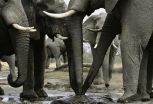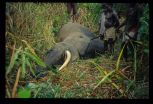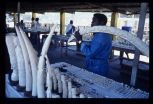DNA from illegal ivory points to poaching hotspots in Africa
2015-06-18
(Press-News.org) This news release is available in Japanese.
New genetic tools are helping researchers to trace illegal ivory back to the elephant populations from which it came, and they might help law enforcement crack down on poaching in the future. Elephant poaching is happening at rates that threaten African populations with extinction. After analyzing 28 ivory seizures made between 1996 and 2014 -- each of them containing half a ton of tusks or more -- Samuel Wasser and colleagues suggest that the illegal ivory trade has been fueled primarily by two poaching hotspots in Africa since about 2006. However, these regions probably won't remain hotspots for long, according to the researchers. Their data suggest that poachers move on to new pastures fairly soon after such hotspots are identified. To determine the locations of major elephant poaching sites, the researchers first sampled DNA from the dung of 1,350 elephants -- both savanna and forest elephants -- from 71 different locations across 29 African countries, using their results to create a map of elephant populations. They then analyzed DNA in large seizures of ivory and assigned them to specific elephant populations across the continent. Their results suggest that 96% of ivory seizures originated from a total of four geographical areas -- and that after 2007, the vast majority of ivory seizures became concentrated in just two areas. In the past nine years or so, most savanna elephant tusks have come from Tanzania and Mozambique while most forest elephant tusks have originated in Gabon, the Republic of Congo, or the Central African Republic, according to the researchers. Their findings indicate that most ivory seizures were shipped (or about to be shipped) out of a different country from where they originated. The researchers suggest that their DNA forensics technique could be adapted for other animals as well -- and that its accuracy could be improved to help law enforcement identify poaching hotspots in time to mount coordinated, international responses. Right now, the illegal trade of wildlife has become the world's fourth largest transnational organized crime, they say, and African ivory represents a major part of that trade. A Perspective article by A. Rus Hoelzel explains these findings and their implications in greater detail.
INFORMATION:
Article #20: "Genetic assignment of large seizures of elephant ivory reveals Africa's major poaching hotspots," by S.K. Wasser; L. Brown; C. Mailand; S. Mondol; C. Laurie; B.S. Weir at University of Washington in Seattle, WA; W. Clark at INTERPOL in Lyon, France; S. Mondol at Wildlife Institute of India in Chandrabani, India.
ELSE PRESS RELEASES FROM THIS DATE:
2015-06-18
This news release is available in Japanese.
Researchers have found evidence of shared decision-making among a troop of wild baboons, providing insight into how animals that live in socially complex, hierarchical societies reach consensus on decisions that affect the entire group. Until now, researchers had wondered if animals with clear hierarchies, such as primates or wolves, use democracy to reach a consensus -- or if their decisions are governed by dominant leaders. It's been difficult to study this, however, because recording the behavior of many individuals simultaneously ...
2015-06-18
This news release is available in Japanese. A new study aiming to provide a better understanding of how injection wells in the U.S. influence earthquake activity cites wastewater injection rate as a critical factor. In the study, the highest-rate wastewater disposal wells analyzed were nearly twice as likely to be associated with earthquake events compared to their lower-rate counterparts. Earthquakes can be induced by industrial processes, a fact established decades ago. Since 2009, when seismicity in the U.S. midcontinent began to surge, earthquakes induced by the underground ...
2015-06-18
This news release is available in Japanese. Opening Iran's national uranium enrichment plant to multinational involvement could limit the long-term risks of Iran's nuclear program as restrictions on it expire, according to this Policy Forum. In July, Iran is expected to sign an agreement restricting its nuclear program, but also affirming its right to pursue uranium enrichment as those restrictions end in 2025 and beyond. Authors Alexander Glaser, Zia Mian, and Frank von Hippel suggest that selling shares of Iran's uranium enrichment plant to other countries could help ...
2015-06-18
PRINCETON, N.J.--Within the next two weeks, or soon after, the United States and five world powers hope to finalize a nuclear deal with Iran to limit its nuclear activities in exchange for a relaxing of international economic and financial sanctions. But what happens in 10 years when some of the key restrictions being discussed begin to phase out?
One of the biggest concerns is Iran's uranium enrichment program, which uses high-speed centrifuges to produce uranium enriched to a level appropriate for nuclear power reactor fuel. Enrichment plants like this can be quickly ...
2015-06-18
Well-practiced motor skills like riding a bike are extremely stable memories that can be effortlessly recalled after years or decades. In contrast, a new study publishing in PLOS Computational Biology shows that changes to motor skill memories occurring over the course of a single practice session are not immediately stable, according to researchers Andrew Brennan and Maurice Smith of Harvard University School of Engineering and Applied Science and Center for Brain Science.
We're all familiar with the old saying that you never forget how to ride a bike and perhaps personally ...
2015-06-18
Chlamydia trachomatis is a formidable foe. It's the most common sexually transmitted pathogen, infecting more than 100 million people each year. In the developing world, chlamydial infection is the leading cause of preventable blindness. Around the world, it ranks as the number one cause of infertility and ectopic pregnancy.
Chlamydial infection ignites chronic inflammation, which scars mucosal surfaces such as eyelids, ovaries or fallopian tubes. Most people who carry the bacterium don't know it. Women with chlamydia are much more vulnerable to other sexually transmitted ...
2015-06-18
To predict how a seasonal influenza epidemic will spread across the United States, one should focus more on the mobility of people than on their geographic proximity, a new study suggests.
PLOS Pathogens published the analysis of transportation data and flu cases conducted by Emory University biologists. Their results mark the first time genetic patterns for the spread of flu have been detected at the scale of the continental United States.
"We found that the spread of a flu epidemic is somewhat predictable by looking at transportation data, especially ground commuter ...
2015-06-18
Baboons live in a strongly hierarchical society, but the big guys don't make all the decisions.
A new study from the University of California, Davis, reveals -- through GPS tracking -- that animals living in complex, stratified societies make some decisions democratically. The study breaks ground in how animal behavior data is collected.
The study is being published Friday (June 19) in Science.
"It's not necessarily the biggest alpha males that influence where groups go," said co-author Meg Crofoot, assistant professor of anthropology at UC Davis. "Our results illustrate ...
2015-06-18
DNA from the 8,500-year-old skeleton of an adult man found in 1996, in Washington, is more closely related to Native American populations than to any other population in the world, according to an international collaborative study conducted by scientists at the University of Copenhagen and the Stanford University School of Medicine.
The finding challenges a 2014 study that concluded, based on anatomical data, that Kennewick Man was more related to indigenous Japanese or Polynesian peoples than to Native Americans. The study is likely to reignite a long-standing legal ...
2015-06-18
NASA provided four different views of Tropical Depression Bill as it continued traveling through the south-central U.S. and into the Ohio Valley. NASA's Aqua and Terra satellite provided infrared and visible imagery while NASA/NOAA's GOES Project animated NOAA's GOES-East satellite imagery to show the storm's progression since landfall. The Global Precipitation Measurement or GPM core satellite also showed rainfall estimates and locations.
On June 18, the National Weather Service, Weather Prediction Center (NWS/WPC) noted that flood and flash flood watches and warnings ...
LAST 30 PRESS RELEASES:
[Press-News.org] DNA from illegal ivory points to poaching hotspots in Africa




